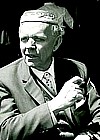Hofrat Mag. Leopold Buchsbaum

Personalia
Born:
Died:
Profession:
Persecution:
Imprisonment 12.03.1938 - 02.04.1938,
Dachau concentration camp 02.04.1938 - 27.09.1939,
Flossenbürg concentration camp 27.09.1939 - 02.03.1940,
Dachau concentration camp 02.03.1940 - 16.07.1940,
Discharge 1938
KZ Number:
Memberships
Curriculum Vitae
Leopold Buchsbaum was born in Korneuburg near Vienna, the son of the shipyard carpenter of the same name, Leopold Buchsbaum, and Elisabeth, née Schmöllerl. After elementary school, he attended the Landes Real- und Obergymnasium in Stockerau, where he graduated in 1907. In the same year, he enrolled in law at the University of Vienna and became one of the first foxes to join the Korneuburg fraternity Danubia. He receives a scholarship from the Rosalia Czech Foundation. He completes his studies with a diploma, completes his one-year voluntary service in 1912/13 and joins the Vienna Imperial and Royal Police Directorate as a concept trainee. During the First World War, he was commissioned as a lieutenant.
After the war, he joined the school department of the Vienna Security Guard in 1920 after working as a police commissioner in various departments, where he became deputy commander. From 1930, he worked in the Central Inspectorate of the Security Guard, and from 1933 as a personnel officer. In this role, he naturally had a lot to do with disciplinary matters involving illegal National Socialists in the police service. During the corporative state, he worked in various functions and within the framework of the Patriotic Front as a representative of the police officers and head of the provincial branch.
Leopold Buchsbaum was arrested by an SS commando during a meeting at police headquarters on the night of March 11-12, 1938 and taken to Elisabethpromenade. He was transferred to the Dachau concentration camp with the so-called 'Prominent Transport' of April 2, 1938 as No. 9 on the Gestapo list and then transferred from there to the Flossenbürg concentration camp on September 27, 1939. On March 2, 1940, he was transferred back to Dachau concentration camp and remained there until his release on July 16, 1940. He was dismissed from the police service on the basis of the "Ordinance on the Reorganization of the Austrian Professional Civil Service".
After his imprisonment in the concentration camp, he was forced to report to the Gestapo twice a week because he was in poor health (48 kg). He managed to get by as a representative of a coal wholesaler and as an office assistant in the "Association of the East Mark Brandenburg Paper Industry". As a member of the resistance group '05' and, from September 1944, the group 'Free Austria', he is actively involved in the resistance.
After the liberation of Austria, he was immediately rehabilitated, played a leading role in the reconstruction of the police force, was appointed Court Councillor and served as Chairman of the Disciplinary Commission of the Vienna Federal Police Directorate until his retirement. He joins the ÖVP-Kameradschaft der politisch Verfolgten und Bekenner für Österreich.
As a civil servant, he retires and dies in Vienna at the age of 87.
Places
Persecution:
Residence:
Citations
Krause, Peter/Reinelt, Herbert/Schmitt, Helmut (2020): Farbe tragen, Farbe bekennen. Katholische Korporierte in Widerstand und Verfolgung. Teil 2. Kuhl, Manfred (ÖVfStG, Wien) S. 40/41.
Wiener Stadt- und Landesarchiv (WStLA)
Archiv der Universität Wien
